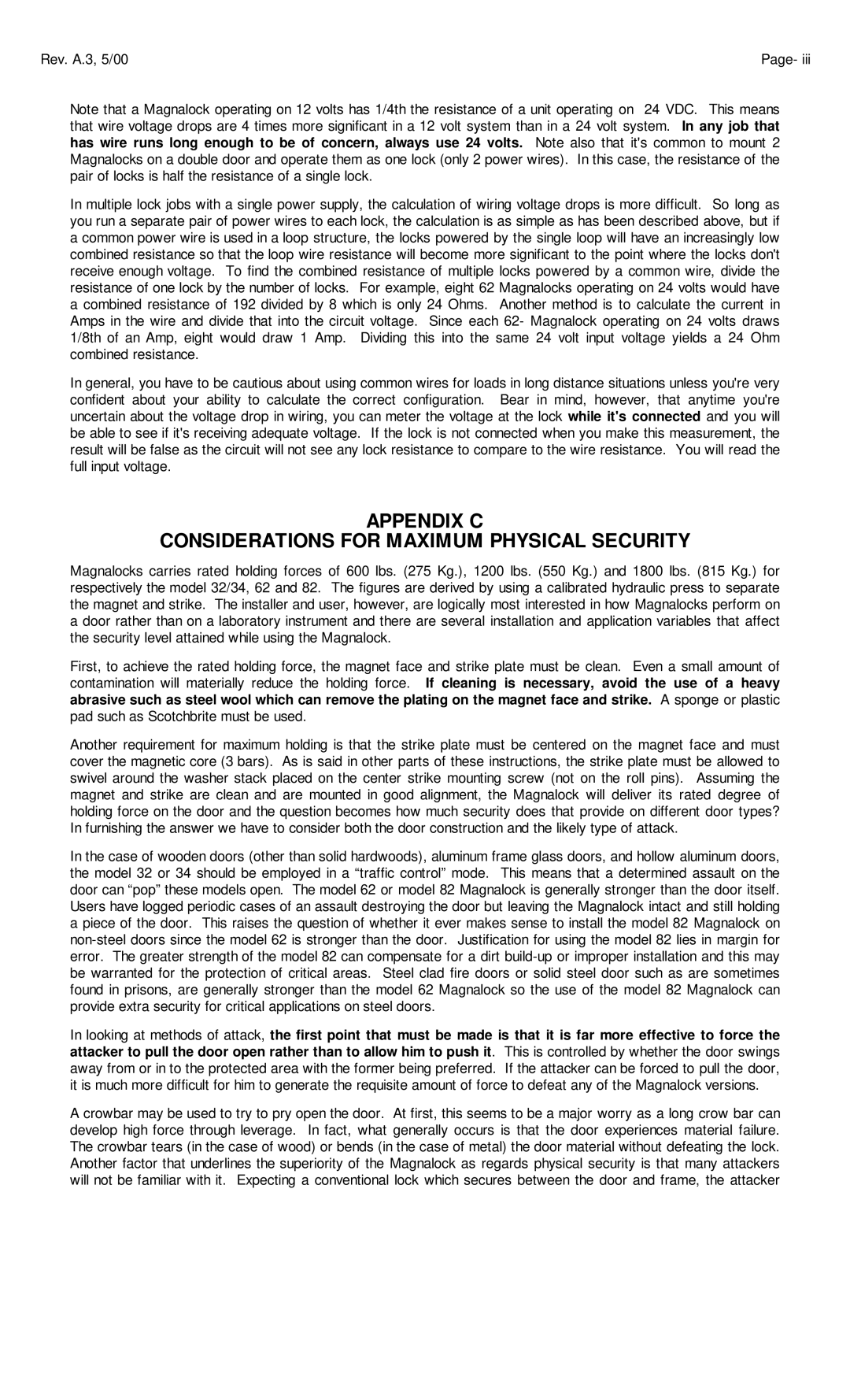Rev. A.3, 5/00 | Page- iii |
Note that a Magnalock operating on 12 volts has 1/4th the resistance of a unit operating on 24 VDC. This means that wire voltage drops are 4 times more significant in a 12 volt system than in a 24 volt system. In any job that has wire runs long enough to be of concern, always use 24 volts. Note also that it's common to mount 2 Magnalocks on a double door and operate them as one lock (only 2 power wires). In this case, the resistance of the pair of locks is half the resistance of a single lock.
In multiple lock jobs with a single power supply, the calculation of wiring voltage drops is more difficult. So long as you run a separate pair of power wires to each lock, the calculation is as simple as has been described above, but if a common power wire is used in a loop structure, the locks powered by the single loop will have an increasingly low combined resistance so that the loop wire resistance will become more significant to the point where the locks don't receive enough voltage. To find the combined resistance of multiple locks powered by a common wire, divide the resistance of one lock by the number of locks. For example, eight 62 Magnalocks operating on 24 volts would have a combined resistance of 192 divided by 8 which is only 24 Ohms. Another method is to calculate the current in Amps in the wire and divide that into the circuit voltage. Since each 62- Magnalock operating on 24 volts draws 1/8th of an Amp, eight would draw 1 Amp. Dividing this into the same 24 volt input voltage yields a 24 Ohm combined resistance.
In general, you have to be cautious about using common wires for loads in long distance situations unless you're very confident about your ability to calculate the correct configuration. Bear in mind, however, that anytime you're uncertain about the voltage drop in wiring, you can meter the voltage at the lock while it's connected and you will be able to see if it's receiving adequate voltage. If the lock is not connected when you make this measurement, the result will be false as the circuit will not see any lock resistance to compare to the wire resistance. You will read the full input voltage.
APPENDIX C
CONSIDERATIONS FOR MAXIMUM PHYSICAL SECURITY
Magnalocks carries rated holding forces of 600 lbs. (275 Kg.), 1200 lbs. (550 Kg.) and 1800 lbs. (815 Kg.) for respectively the model 32/34, 62 and 82. The figures are derived by using a calibrated hydraulic press to separate the magnet and strike. The installer and user, however, are logically most interested in how Magnalocks perform on a door rather than on a laboratory instrument and there are several installation and application variables that affect the security level attained while using the Magnalock.
First, to achieve the rated holding force, the magnet face and strike plate must be clean. Even a small amount of contamination will materially reduce the holding force. If cleaning is necessary, avoid the use of a heavy abrasive such as steel wool which can remove the plating on the magnet face and strike. A sponge or plastic pad such as Scotchbrite must be used.
Another requirement for maximum holding is that the strike plate must be centered on the magnet face and must cover the magnetic core (3 bars). As is said in other parts of these instructions, the strike plate must be allowed to swivel around the washer stack placed on the center strike mounting screw (not on the roll pins). Assuming the magnet and strike are clean and are mounted in good alignment, the Magnalock will deliver its rated degree of holding force on the door and the question becomes how much security does that provide on different door types? In furnishing the answer we have to consider both the door construction and the likely type of attack.
In the case of wooden doors (other than solid hardwoods), aluminum frame glass doors, and hollow aluminum doors, the model 32 or 34 should be employed in a “traffic control” mode. This means that a determined assault on the door can “pop” these models open. The model 62 or model 82 Magnalock is generally stronger than the door itself. Users have logged periodic cases of an assault destroying the door but leaving the Magnalock intact and still holding a piece of the door. This raises the question of whether it ever makes sense to install the model 82 Magnalock on
In looking at methods of attack, the first point that must be made is that it is far more effective to force the attacker to pull the door open rather than to allow him to push it. This is controlled by whether the door swings away from or in to the protected area with the former being preferred. If the attacker can be forced to pull the door, it is much more difficult for him to generate the requisite amount of force to defeat any of the Magnalock versions.
A crowbar may be used to try to pry open the door. At first, this seems to be a major worry as a long crow bar can develop high force through leverage. In fact, what generally occurs is that the door experiences material failure. The crowbar tears (in the case of wood) or bends (in the case of metal) the door material without defeating the lock. Another factor that underlines the superiority of the Magnalock as regards physical security is that many attackers will not be familiar with it. Expecting a conventional lock which secures between the door and frame, the attacker
